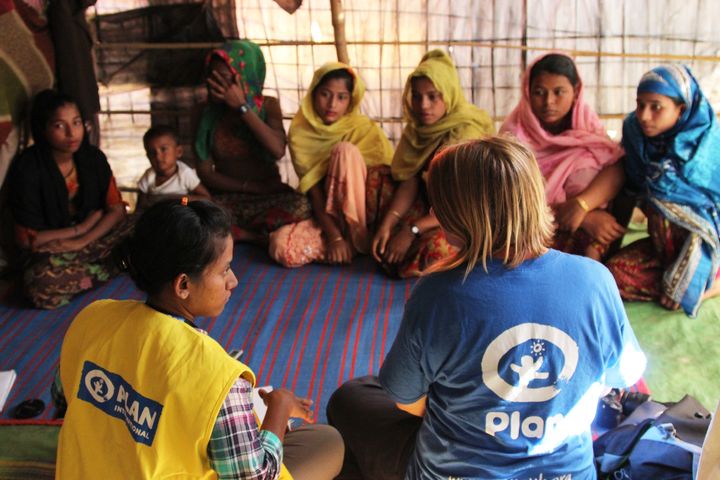
One year since the mass exodus of the Rohingya people from Myanmar began, international media attention has started to die down. But for the 700,000 people who have crossed the border into Bangladesh fleeing from violence and persecution, things are far from over.
In May, I visited the Rohingya refugee camps in Cox’s Bazar, to see Plan International’s response to the crisis. The conditions in the world’s largest refugee camp are like nothing I could have imagined. Many refugees don’t have adequate access to clean water, education or food. They have to walk for hours to find firewood or use the toilet, and many don’t have anything to help them stay clean.
The landscape, which goes on for miles, is made up of bamboo shelters with plastic tarpaulin balanced precariously on sandy hills, dirt paths winding their way up and down the mountain sides and not a single tree left as each one has been used for firewood (there was a forest in this region before the refugees came). The temporary nature of these shelters has brought fresh challenges for the refugees here. When I was there, the monsoon season was about to begin, and many were being relocated from areas at high risk of flooding and mudslides, or working hard to reinforce their homes. They were also terrified of wild elephants, who use the area the camps have been built on as migration corridors and have trampled several homes, and even people, as they wade into the camps.
Despite the challenges, life is going on as normally as possible, and as you walk through the camps you hear babies crying, are waved at by intrigued young children and see men doing physical labour like digging ditches for rainwater. What is noticeably missing, though, is the presence of adolescent girls.
This is because every day they remain in their stiflingly hot shelters (it was about 33 degrees outside the shelters), instead of going outside. There are many reasons for this – culturally, when a girl reaches puberty in the Rohingya community she stays at home until she is married. She can then leave the home wearing a burka. But another reason girls are confined to their homes is that they are incredibly scared to venture out on their own. They are afraid of harassment by men they don’t know, and fear that wild animals will come. Many are marrying in the camps, with the hope this will afford them extra protection.
Having no adequate way to manage their period is another barrier to leaving their shelters. One 18-year-old, Khurshida, told me she didn’t have any menstrual products to help her manage her period so she would instead use dirty pieces of cloth. So far, Plan International has distributed 12,000 hygiene kits, 10,000 dignity kits – including things like sanitary pads, underwear, a torch and slippers - and held 750 hygiene sessions for girls to share information and learn about menstrual hygiene. Sitting in on one of these sessions, I could see how much the girls enjoyed a rare chance to be together and talk openly with girls their own age.
But we know that girls will always be most at risk when emergencies happen, and more support from the international community is needed to reach more girls. Far from being over a year on, this is a crisis that will continue long into the future. The Rohingya people have no idea if they’ll ever be able to return to their homes and be safe in their own country. The international response now needs to ensure that those in the camps – especially the adolescent girls who feel so isolated – are given the ongoing skills and resources they need to protect themselves, their homes and their families, as they try to rebuild their lives.
